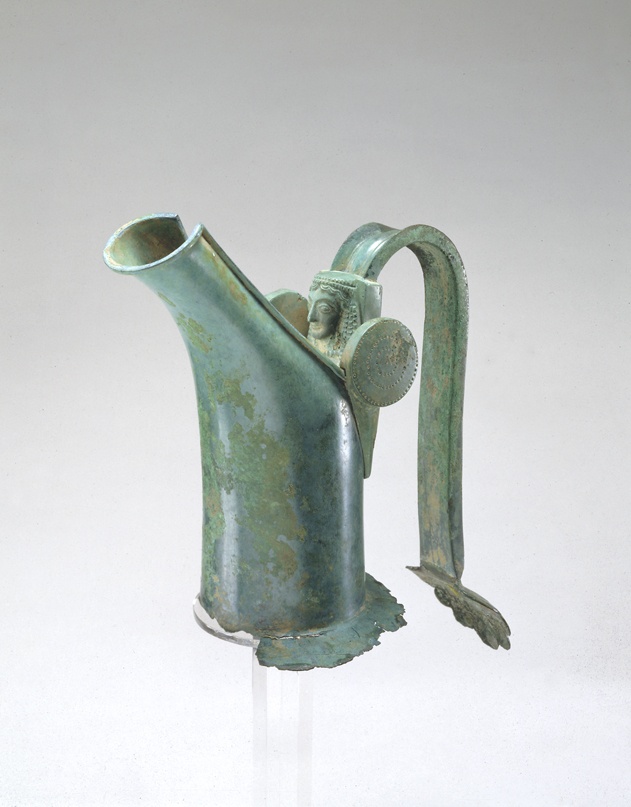
Bronze
H: 11.65 cm
Vitsa (Epirus)
Corinthian
c. 580 B.C. (Late Middle Corinthian)
The body, neck and mouth made by hammering from a sheet of bronze possibly already cast into an appropriate shape. The grooved handle cast by the lost wax process with the palmette hammered. Two rivets attached the upper part of the handle to the neck of the vessel and the palmette on the lower part was affixed to the vessel's shoulder with tin solder. The protome on the handle, the two discs and the palmette itself carefully chased and cold-worked.
Condition: casting defect to the back of the handle behind the right side of the protome.
Patina: green to light green, typical for Dodona.
A very interesting comparison [1] is the protome in bronze on a similar handle in Athens [2], almost identical in spirit though certain details on it, such as the eyes, are different in execution since it is slightly earlier in date. The female protome itself has parallels in terracotta and we are at a high moment of Corinthian plastic creation, when terracotta, bronze and marble sculpture shared similar characteristics and expressed a common ethos.
This purely Corinthian production is at the beginning of a series of bronze oinochoai with the female mask close to Early Middle Corinthian terracotta protomes; the engraved palmette flat (it becomes more plastic as the series evolve); and the body of the vessel [3] squat, with slightly curved shoulder and low foot-ring.
As a production develops, most of the extant examples of the type are made by local North Greek workshops imitating the Corinthian model.
Exhibited and Published:
Art Antique, cat. no. 175, ill.
Hommes et Dieux, cat. no. 106, pp. 180, 181 col. pl.
Published:
Vokotopoulou, J.: Chalkai korinthiourgeis prochoi (Athens, 1975), no. 2, pp. 14, 86, 102, 177 pl. 15.
id.:Vitsa. Ta necrotapheia mias molossikes komes (Athens, 1986), pp. 44-45, pl. 62, 63.
1 The information used in this entry is due in part to Dr. Julia Vokotopoulou.
2 National Museum, Carapanos collection 341: Vokotopoulou, J.: Chalkai Korinthiourgeis Prochoi, pl. 14 a+b.
3 J. Vokotopoulou (Vitsa, pp. 44-45, no. 3, pl. 61) has identified the body of an oinochoe, Joannina Museum 2254, as belonging to our handle.